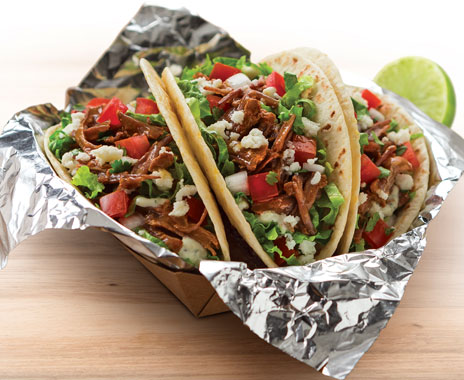Van Ingram, the vice president of franchise development at Taco John’s, reels off the numbers. “We went from 15 to 24 to 50 in three years,” he says. “In fact, we just opened one this morning.”
Ingram and the brand’s CEO, Jim Creel, are preparing for this sort of whirlwind in 2017, something Taco John’s hasn’t experienced in quite some time. The 392-unit Mexican chain, founded in 1969 in Cheyenne, Wyoming, was enjoying steady growth before last year’s metrics dynamited the doors off.
In 2016, they set a company record by inking 50 new franchise commitments for locations in the coming years. They’re signed up for Indianapolis, Nashville, Chattanooga, Tennessee, and New York. Final discussions are underway in Columbus, Ohio, Fort Walton Beach, Florida, Lexington, Kentucky, and Bowling Green, Kentucky. There’s also an airport unit in the works, as well as a 10-store commitment with Love’s Travel Plazas—one of the largest plaza operators in the U.S.
Creel has a clear mind about the growth, about where it’s headed and why the brand is suddenly enjoying such rapid movement.
“I think part of it is we’re in a category that only really has one national competitor in Taco Bell. And we’ve built a lot of excitement from our core customers and our core territories,” he says. “And a lot of those people now have moved to other parts of the country. So they’re wanting to bring that taste of Taco John’s to some new areas that we haven’t been in before.”
There’s something to be said about running second in a race. Especially when that field, as is the case in the Mexican-themed quick-serve universe, feels as crowded as Times Square before the ball drops. Not only does Creel and Ingram see the value of being No. 2, but franchisees are starting to recognize it as well.
“If they’re savvy franchisees, they look around and think, ‘If I want to get into a new brand, do I want to get into the burger category where I have five or 10 national concepts out there trying to make their way into the market? The same with pizza chains or chicken and sandwich chains. When they look in the Mexican [quick service] category you have Taco Bell, of course, as the industry leader and really no clear-cut secondary competitor in most markets. And that’s why we’ve really targeted a lot of those central U.S. and Mid-Atlantic markets because you have Taco Bell and Taco Bell only. And they see the ability to go in and take that No. 2 position.”
Creel says Taco John’s is spice and flavor forward, and there’s also a salsa bar, which sets it apart. Not to mention, the brand has cultivated all-day appeal for years. The company says 8 percent of all business comes during breakfast hours, while 37 percent arrives after 4 p.m. Dinner and late-night snacking is a major component of its model, which positions Taco John’s firmly in the millennial market as well as the traditional one. They even trademarked the term “Taco Tuesday” in 1989.
“It continues as one of our most successful ongoing promotions,” Ingram says.
Creel also credits Taco John’s recent success to its ability to stay current. In January, the chain was one of four to receive an innovation award from The International Foodservice Manufacturers Association, joining Arby’s, Chick-fil-A, and Granite City Food & Brewery.
Taco John’s was honored in culinary/operations in the regional chain category for its Street Taco promotion, as well as the introduction of Chicken and Gravy Breakfast Burrito and Chicken Quesadilla Taco menu items.
In 2017, Creel says Taco John’s plans to add some new proteins, including carnitas and steak. “We’re trying to appeal to a broad audience of consumers out there,” he says.
Taco John’s only has 10 company owned stores. That means its current performance and future outlook is only going to be as strong as its franchise system, Ingram says.
When Ingram, a former Arby’s exec, joined the company in 2013, he did something that was counter-intuitive for most chains looking to grow: He actually raised the financial requirements necessary to become a franchisee.
“I wanted to make sure we were bringing in well-capitalized prospects who could take on larger development agreements,” he says, “and that they have the infrastructure to go out and grow a market quickly for us.”
Next, Ingram subscribed to Restaurant Trends, a company that specializes in competitive data, and developed a market optimization tool that helps prospective franchisees target real estate initiatives that appear to have a greater likelihood of success.
“Coming in, it was how do we increase our pipeline or our funnel? How do we take our brand out into new markets where potentially a lot of the customers might not have heard of Taco John’s? They’re obviously [quick service] Mexican customers. So how do we do that?” he says. “One way was to bring in well-capitalized franchisees and then give them the tools to help target their development toward the most viable trade areas.”
The airport and travel center locations are going to be billboards for the brand, Creel says. It also shows that Taco John’s—now primarily in freestanding units—is open to alternative venues. They’re targeting the I-75 and I-64 corridor, including Knoxville, Tennessee, Louisville, Cincinnati, Dayton, Ohio, Toledo, Ohio, and Detroit.
“I think this year we’re actually going to add some development staff in order to concentrate on new franchisees as well as existing franchisees,” Creel says. “We believe there’s growth in both of those areas and so we’re again going to expand our staff in order to expand on both opportunities.”

